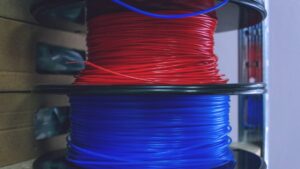
3D Printers and Humidity Levels: What You Need To Know
Those interested in 3D printing have a lot to learn on how to use the system properly. Find out what you need to know about 3D printing and humidity levels.
844-810-1385
3D printing has revolutionized how industries use materials. However, not all 3D printing materials are equal. While we frequently look at everything from color to tensile strength, 3D printing filament also varies significantly in density, directly impacting use and function. In this exploration, we’ll look at the different densities of 3D printing materials and why they matter to the end product.
Class time. Pay attention; there will be a quiz. Density is defined as mass per unit volume. But first—mass is not weight, though the two are related and often confused. When you buy a 1 kg spool, its mass is 1 kg (1000 grams, or g)—in Cleveland or on the moon. Its weight, however, would be quite different in those two locales. If that spool displaces, say, 3 liters of air (3000 cubic centimeters, or cm3), then its density is 1000 g / 3000 cm3, or 0.333 g/cm3. Whew! Math class is over.
Professionals use grams per cubic centimeter (g/cm³) to measure 3D printing filament density so that everyone is on the same page. Manufacturers and hobbyists alike choose materials based on their mechanical properties and density to achieve specific buoyancies, performance criteria, or even for realistic prototyping. This allows the printer to determine the final part mass from the volume of filament used.
To understand density in 3D printing is to appreciate it in the context of real-world applications. For instance, lighter parts might be favorable in aerospace due to fuel efficiency needs, but a certain amount of material is needed to print any job. Thus, for a given amount of filament, a lower-density filament will result in less mass (and a lower weight). Furthermore, the density of printed material can also determine manufacturing costs, the size of an object, and the time required to print it.
3D printing professionals continue to expand their knowledge by experimenting with new filament formulations to match density requirements for emerging needs. TPU filament, for example, is carving out its niche as a flexible material with a density of around 1.14 g/cm3, less dense than PLA and on par with Nylon. Given the incredible toughness of TPU, this makes it a unique offering in certain scenarios.
You may feel like you just dove into a physics lesson, but understanding density in 3D printing is a step toward mastery of your craft. Proficiency in material selection is important to produce the best printed parts possible.
Now, that quiz. To whom can you turn to find the best filament fit for your next project? If you answered Filamatrix, you’re a forward thinker. Congratulations!
For that project, remember that the difference might be in the details, and density just might make or break the deal. For the highest precision in your prints that demand elasticity and specific weight requirements, consider taking the next step with TPU 3D printer filament from Filamatrix. Your creations are in your hands.
FILAMATRIX
NEVER. FEEL. LIMITED.

Those interested in 3D printing have a lot to learn on how to use the system properly. Find out what you need to know about 3D printing and humidity levels.

3D printing has many variables that both beginners and experts need to know. Find out what effects temperature has on 3D printer filament.

Filaments print differently and yield varying quality results. What about quality variations within a filament family due to color? Let’s take a deeper look.
Get professional insights, industry news, and our latest deals